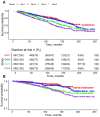Association of aggregate index of systemic inflammation with increased all-cause and cardiovascular mortality in female cancer patients
- PMID: 40365348
- PMCID: PMC12069043
- DOI: 10.3389/fonc.2025.1552341
Association of aggregate index of systemic inflammation with increased all-cause and cardiovascular mortality in female cancer patients
Abstract
Background: Cancer is a leading cause of death, especially among women, with cancers like breast, ovarian, and cervical cancer presenting unique diagnostic and treatment challenges. Systemic inflammation plays a significant role in cancer progression, affecting both tumor development and therapeutic outcomes. Despite the established link between inflammation and cancer, comprehensive studies on the prognostic value of the Aggregate Index of Systemic Inflammation (AISI) in female cancer patients are lacking. This study explores the association between AISI and mortality outcomes, including all-cause and cardiovascular mortality, in female cancer patients.
Methods: This study analyzes data from the NHANES database and Dandong Central Hospital. Kaplan-Meier survival curves and multivariable Cox proportional hazards regression analyses were used to assess the relationship between AISI and all-cause and cardiovascular mortality. Restricted cubic spline plots and subgroup analyses were applied to explore potential interactions.
Results: Elevated AISI levels were strongly associated with increased all-cause and cardiovascular mortality. Patients in the highest AISI quartile demonstrated significantly higher mortality risks compared to those in the lowest quartile. ROC curve analysis indicated superior predictive performance of AISI over SII. Restricted cubic spline plots revealed a linear relationship, with mortality risk notably increasing when AISI levels were elevated.
Conclusion: AISI is a robust predictor of all-cause and cardiovascular mortality in female cancer patients. Its ease of measurement and strong prognostic value make it a valuable tool for risk assessment and management in this population.
Keywords: AISI; NHANES; aggregate index of systemic inflammation; female cancer; mortality.
Copyright © 2025 Yang, Hu, Ye, Wu, Sun and Wang.
Conflict of interest statement
The authors declare that the research was conducted in the absence of any commercial or financial relationships that could be construed as a potential conflict of interest.
Figures





Similar articles
-
The aggregate index of systemic inflammation (AISI) and the risk of all-cause, cardiovascular, and cardio-cerebrovascular mortality in congestive heart failure patients: results from NHANES 1999-2018.Sci Rep. 2025 May 26;15(1):18282. doi: 10.1038/s41598-025-01196-8. Sci Rep. 2025. PMID: 40414913 Free PMC article.
-
[Association Between the Aggregate Index of Systemic Inflammation and Albuminuria: A Cross-Sectional Study of National Health and Nutrition Examination Survey 2007-2018].Sichuan Da Xue Xue Bao Yi Xue Ban. 2024 May 20;55(3):671-679. doi: 10.12182/20240560108. Sichuan Da Xue Xue Bao Yi Xue Ban. 2024. PMID: 38948283 Free PMC article. Chinese.
-
The aggregate index of systemic inflammation (AISI): a novel predictor for hypertension.Front Cardiovasc Med. 2023 May 17;10:1163900. doi: 10.3389/fcvm.2023.1163900. eCollection 2023. Front Cardiovasc Med. 2023. PMID: 37265570 Free PMC article.
-
The association between the aggregate index of systemic inflammation and cardiovascular risk in peritoneal dialysis patients.Nutr Metab Cardiovasc Dis. 2025 May;35(5):103774. doi: 10.1016/j.numecd.2024.10.012. Epub 2024 Oct 20. Nutr Metab Cardiovasc Dis. 2025. PMID: 39638680
-
Aggregate Index of Systemic Inflammation (AISI), Disease Severity, and Mortality in COVID-19: A Systematic Review and Meta-Analysis.J Clin Med. 2023 Jul 10;12(14):4584. doi: 10.3390/jcm12144584. J Clin Med. 2023. PMID: 37510699 Free PMC article. Review.
References
LinkOut - more resources
Full Text Sources

